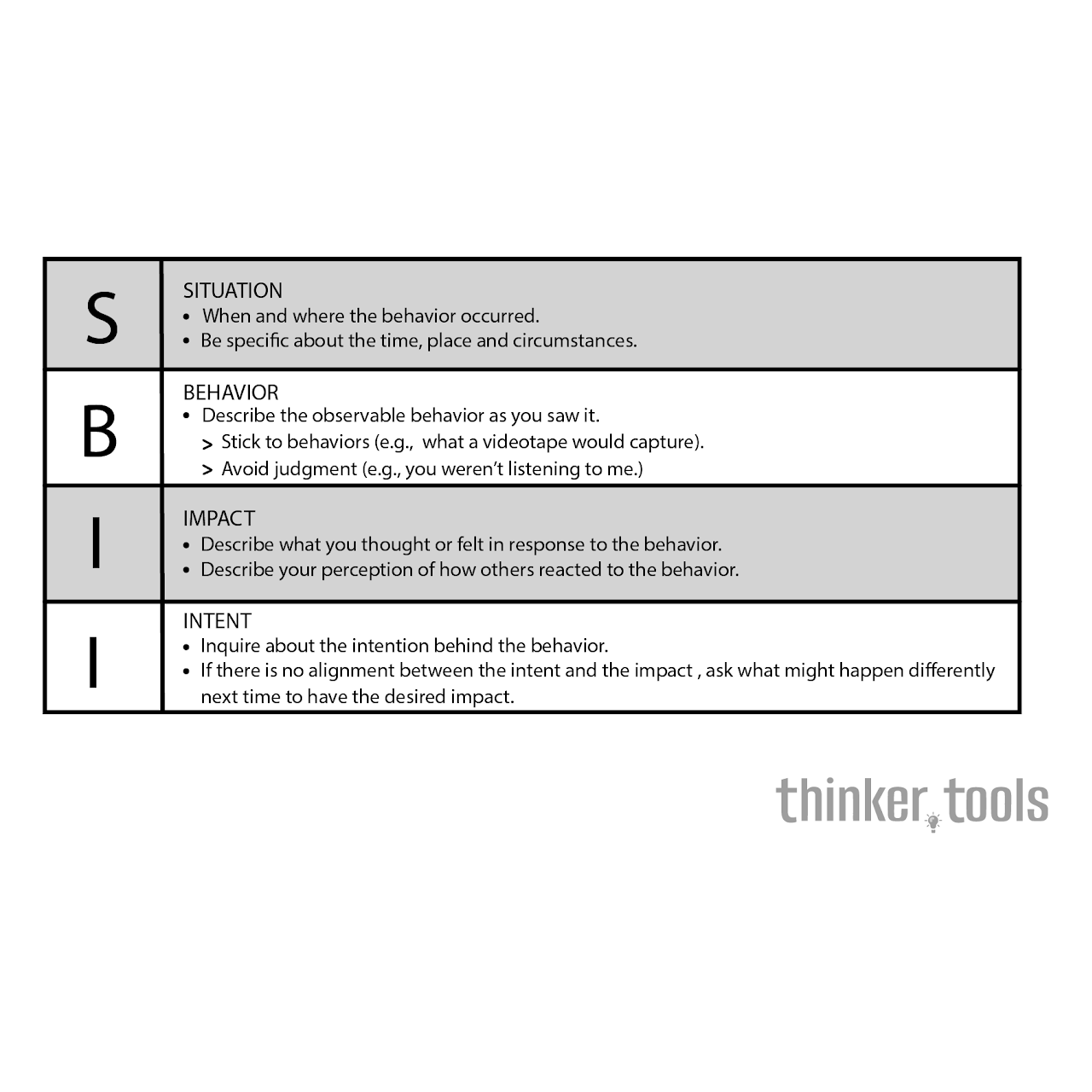
What is the SBII Feedback Model?
The SBII model is a comprehensive feedback framework that breaks down feedback into four clear components: Situation, Behavior, Impact, and Intent. This structure ensures feedback is specific, objective, and focused on behaviors rather than personality judgments. By including intent, it also opens dialogue and prevents defensive reactions.
The model's power lies in its ability to separate facts from interpretations, focus on specific behaviors rather than character assessments, and create space for dialogue rather than one-way criticism. This makes feedback feel less like an attack and more like a collaborative problem-solving conversation.
The History and Origin
The SBII model evolved from the earlier SBI (Situation-Behavior-Impact) model developed by the Center for Creative Leadership in the 1970s. The original SBI model was groundbreaking in its focus on observable behaviors rather than personality traits.
The addition of "Intent" came later as practitioners recognized that understanding someone's intentions could transform defensive conversations into productive dialogues. This evolution reflects growing understanding of emotional intelligence and the importance of psychological safety in feedback conversations.
How to Use the SBII Feedback Model
The Four Components Explained
Situation: Set the context
- When and where did the behavior occur?
- Be specific about time and place
- Help the person recall the exact instance
Behavior: Describe what you observed
- Focus on specific, observable actions
- Avoid interpretations or judgments
- Use neutral, factual language
Impact: Explain the effect
- How did the behavior affect you, others, or outcomes?
- Share your feelings or observed consequences
- Be honest but respectful
Intent: Explore their perspective
- Ask about their intentions
- Listen to understand, not to counter
- Find common ground for moving forward
Step-by-Step Implementation
Step 1: Prepare Your Feedback
Before the conversation:
- Identify specific situations and behaviors
- Clarify the impact you want to discuss
- Check your emotional state
- Choose appropriate time and setting
Step 2: Open with Context
Start positively:
- "I'd like to discuss something I observed"
- "Can we talk about what happened in yesterday's meeting?"
- Express your intent to help, not harm
Step 3: Describe the Situation
Be specific:
- "Yesterday during the team meeting at 2 PM..."
- "When we were discussing the project timeline..."
- "During your presentation to the client..."
Step 4: Explain the Behavior
State facts only:
- "You interrupted Sarah three times"
- "You arrived 20 minutes after the scheduled start"
- "You raised your voice when discussing the budget"
Step 5: Share the Impact
Use "I" statements:
- "I felt frustrated because we couldn't hear Sarah's ideas"
- "I was concerned because the client seemed uncomfortable"
- "The team appeared discouraged after that exchange"
Step 6: Inquire About Intent
Open dialogue:
- "Can you help me understand what was happening for you?"
- "What was your perspective on that situation?"
- "Was there something I might have missed?"
Step 7: Collaborate on Solutions
Work together:
- Listen to their perspective fully
- Find mutual understanding
- Agree on future behavior changes
- Offer support if needed
Practical Examples
Manager to Employee: "During yesterday's client call (Situation), you contradicted the pricing I had just explained (Behavior). This seemed to confuse the client and may have undermined our credibility (Impact). Can you help me understand what you were thinking? (Intent)"
Peer Feedback: "In this morning's brainstorming session (Situation), you shot down three ideas without letting people finish explaining (Behavior). I noticed people stopped contributing after that (Impact). What was going on for you in that moment? (Intent)"
Personal Relationship: "Last night at dinner with my parents (Situation), you mentioned my past mistakes twice (Behavior). I felt embarrassed and it made me withdraw from the conversation (Impact). Were you aware of how those comments might affect me? (Intent)"
Team Dynamics: "During sprint planning yesterday (Situation), you took on five major tasks (Behavior). I'm concerned you'll burn out and the team won't get exposure to those areas (Impact). What's driving your desire to take on so much? (Intent)"
Benefits and Life Impact
Mastering the SBII model transforms your ability to navigate difficult conversations:
Reduced Defensiveness: By focusing on behaviors and including intent, recipients feel heard rather than attacked, making them more receptive to feedback.
Clearer Communication: The structure ensures you communicate specifically what needs to change, avoiding vague complaints that leave people confused.
Stronger Relationships: Respectful, constructive feedback builds trust and shows you care enough to help others grow.
Improved Performance: Clear, actionable feedback helps people understand exactly what to change, leading to better outcomes.
Enhanced Leadership: Leaders who give effective feedback create cultures of continuous improvement and psychological safety.
Personal Growth: Both giving and receiving SBII feedback develops emotional intelligence and self-awareness.
Conflict Prevention: Addressing issues promptly and constructively prevents small problems from becoming major conflicts.
Team Development: Teams that use SBII create environments where feedback is normal and welcome, accelerating collective growth.
Increased Empathy: The intent component helps you understand others' perspectives, building empathy and connection.
The SBII feedback model transforms one of our most challenging interpersonal tasks into a structured, manageable process. By separating facts from judgments and creating space for dialogue, it turns potentially destructive criticism into constructive conversations. In a world where poor feedback damages relationships and limits growth, mastering SBII gives you the tools to help others develop while strengthening your connections. Whether you're a manager, parent, partner, or friend, this framework enables you to address issues directly yet kindly, creating positive change without damaging relationships. The key is practice – the more you use SBII, the more natural it becomes, until giving great feedback is simply how you communicate.